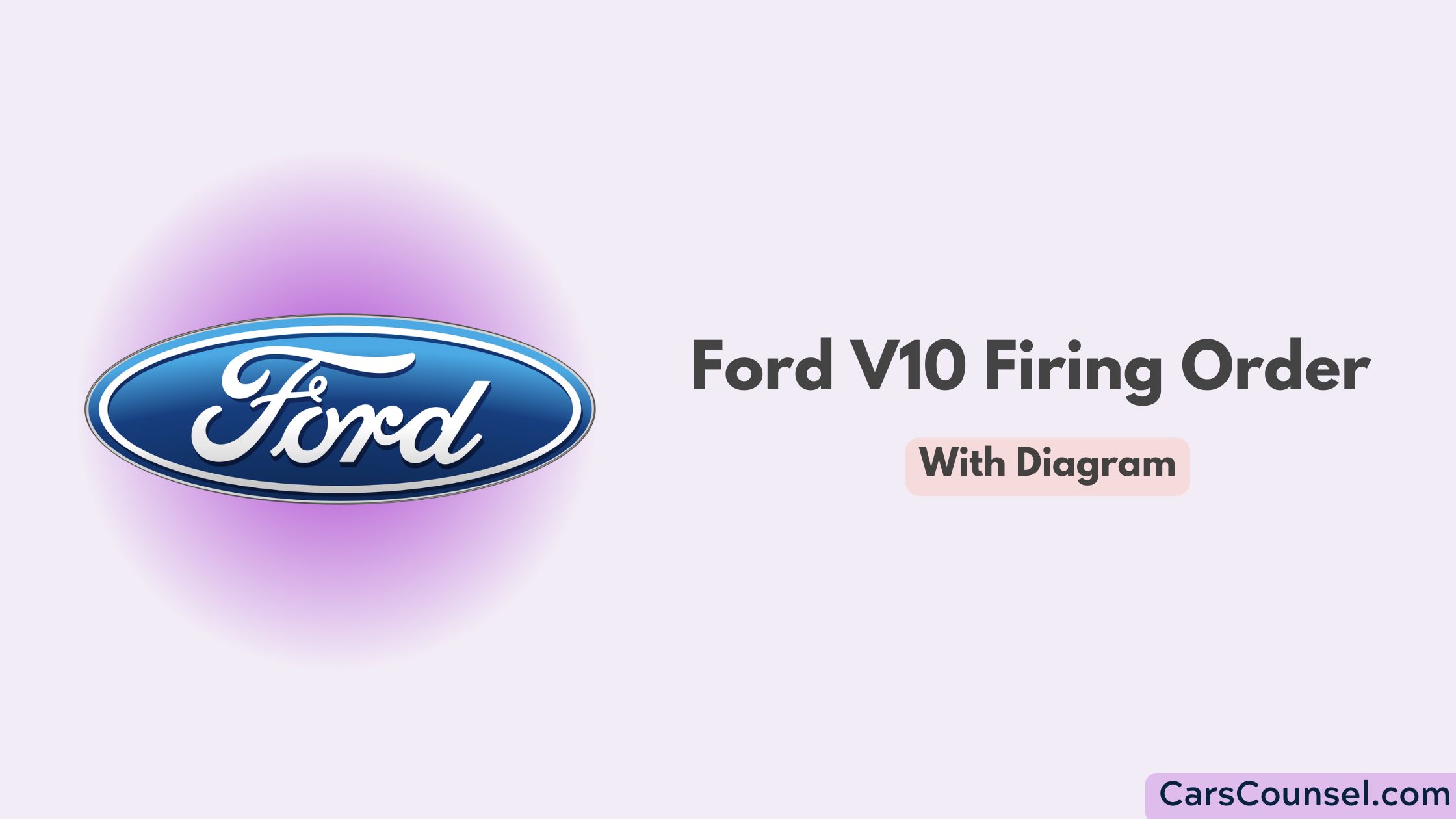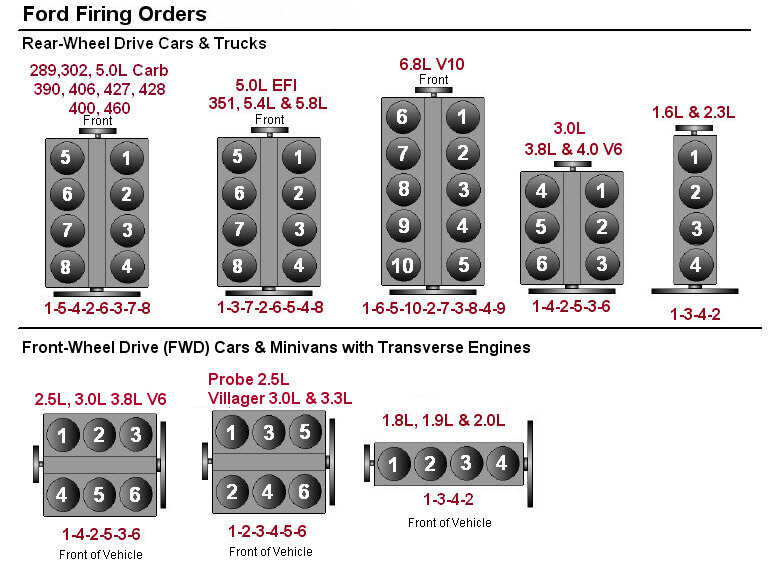The Ford V10 engine, a powerhouse in many trucks, vans, and motorhomes, is part of Ford’s Triton family. Knowing the firing order is crucial for maintaining smooth performance, troubleshooting problems, and enhancing efficiency. This guide delivers the essential facts in a clear, conversational format.

Quick Navigation
Ford V10 Firing Order
The firing order for the Ford V10 engine is 1-6-5-10-2-7-3-8-4-9

This sequence repeats as the engine cycles, ensuring smooth and continuous operation.
What is the Firing Order?
The firing order describes the sequence in which the engine’s cylinders fire. In the Ford V10, the firing order ensures balanced power delivery and efficient operation.
Why the Firing Order Matters
- Engine Smoothness: The correct firing order minimizes vibrations and enhances stability.
- Fuel Efficiency: A proper sequence optimizes combustion, reducing wasted fuel.
- Power Balance: The firing order evenly distributes power across the engine.
- Troubleshooting: Understanding the sequence simplifies diagnosing misfires and timing issues.
Engine Layout and Cylinder Numbering
The Ford V10 engine is a 90-degree V-configuration with 10 cylinders arranged in two banks. Understanding the layout helps in identifying cylinders for diagnostics and maintenance.
Cylinder Numbering
- Bank 1 (Driver’s Side): Cylinders 1, 2, 3, 4, 5.
- Bank 2 (Passenger Side): Cylinders 6, 7, 8, 9, 10.
The numbering starts at the front of the engine and progresses toward the rear on each side.
Components Involved in Firing
Several components work together to execute the firing order:
- Crankshaft: Coordinates piston movement with power delivery.
- Camshaft: Times valve opening and closing in sync with firing.
- Ignition Coil Packs: Generate high-voltage energy for spark plugs.
- Spark Plugs: Ignite the air-fuel mixture in each cylinder.
- PCM (Powertrain Control Module): Controls spark timing and injector operation.
Each part must function correctly to maintain the firing sequence.
How the Firing Order Works
The V10 engine uses a four-stroke cycle for each cylinder:
- Intake Stroke: Air and fuel enter the cylinder.
- Compression Stroke: The piston compresses the mixture.
- Power Stroke: The spark plug ignites the mixture, driving the piston down.
- Exhaust Stroke: The cylinder expels exhaust gases.
The firing order determines the sequence of power strokes, ensuring smooth engine operation.
Common Problems with Firing Order
Misfires: Disruptions in the firing sequence lead to incomplete combustion.
- Symptoms: Rough idling, loss of power, increased emissions.
- Causes: Faulty ignition coils, worn spark plugs, or PCM errors.
Vibrations: An incorrect firing order creates an imbalance.
- Diagnosis: Check ignition coil connections and cylinder performance.
Knocking or Pinging: Poor timing or improper firing causes pre-ignition.
- Prevention: Use high-quality fuel and ensure proper spark timing.
Power Loss: An incorrect sequence reduces engine efficiency.
- Solution: Inspect spark plugs, coils, and PCM programming.
How to Check the Firing Order
- Reference the Manual: Verify the firing order and cylinder numbering.
- Inspect Coil Packs: Ensure each coil delivers spark to the correct cylinder.
- Use Diagnostic Tools: Utilize an OBD-II scanner to identify misfire codes.
- Test Spark Plugs: Check for fouling or improper gaps.
- Perform a Compression Test: Confirm consistent compression across all cylinders.
Adjusting the Firing Order
The firing order in the Ford V10 cannot be changed without altering the engine’s design. However, proper maintenance ensures the factory firing order operates correctly:
- Verify Coil Pack Connections: Ensure wires route to the correct cylinders.
- Check PCM Settings: Ensure the control module synchronizes with the firing order.
- Inspect Timing Chain or Belt: Maintain alignment between the crankshaft and camshaft.
- Replace Worn Components: Address issues with spark plugs, coils, or timing components.
Troubleshooting Firing Order Problems
- Identify Misfire Codes: Use an OBD-II scanner to locate problem cylinders.
- Inspect Coil Packs and Wires: Look for damage, wear, or loose connections.
- Test Spark Delivery: Verify that each plug receives sufficient voltage.
- Check Fuel Injectors: Ensure injectors deliver fuel evenly across cylinders.
- Inspect Timing Components: Address any misalignment in the timing chain or belt.
Maintenance Tips for the Ford V10
- Replace Spark Plugs Regularly: Follow manufacturer intervals for plug replacement.
- Inspect Coil Packs: Check for signs of wear or overheating.
- Clean Injectors: Maintain proper fuel flow to each cylinder.
- Maintain the Timing Chain: Prevent skipping or wear that can disrupt timing.
- Use High-Quality Fuel: Minimize deposits in the combustion chamber.
Performance Considerations
The Ford V10 engine is known for durability and torque. Keeping the firing order intact is crucial for reliable performance:
- Tuning: Retain the factory firing order during tuning for consistent power delivery.
- Aftermarket Upgrades: Use high-performance coils and plugs for improved spark efficiency.
- Compression Testing: Confirm even compression for balanced cylinder firing.
Summary of Key Points
- Firing Order: 1-6-5-10-2-7-3-8-4-9.
- Cylinder Layout: Bank 1 (driver’s side): 1-2-3-4-5; Bank 2 (passenger side): 6-7-8-9-10.
- Critical Components: Crankshaft, camshaft, ignition coils, spark plugs, PCM.
- Common Issues: Misfires, vibrations, power loss, and knocking.
- Maintenance Essentials: Replace spark plugs, inspect coil packs, and maintain timing components.
Engines with Similar Firing Orders
- Ford 400 Firing Order
- Ford 5.0 Firing Order
- Ford 289 Firing Order
- 2001 Ford Explorer Firing Order
- 2001 Ford Explorer Firing Order
Final Thoughts
The Ford V10 firing order (1-6-5-10-2-7-3-8-4-9) is a key factor in the engine’s performance and longevity. Proper maintenance of the ignition system, fuel injectors, and timing components ensures the engine runs efficiently. By understanding the firing sequence and addressing potential issues early, you can keep your Ford V10 operating at its peak, whether in a truck, van, or motorhome.

